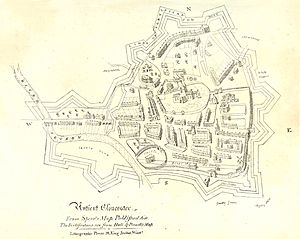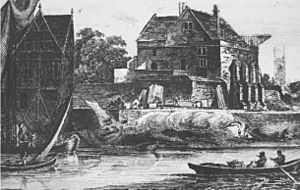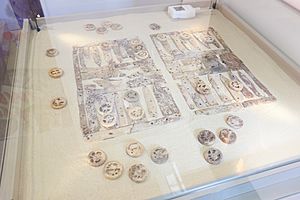Gloucester Castle facts for kids

Gloucester Castle was an old royal castle located in the city of Gloucester, England. It was built during the Norman period. The castle was taken down in 1787. A new building, Gloucester Prison, was built in its place.
Building the First Castle
The castle was likely built by Roger de Pitres. He was the first sheriff of Gloucestershire after the Normans took over England. This happened during the time of William the Conqueror (1066-1087).
It started as a simple motte and bailey castle. This means it had a big mound of earth (the motte) with a tower on top. It also had a walled area (the bailey) below. Sixteen houses were removed to make space for it.
King William II (1087-1100) made the castle bigger. He had eight more houses taken down. Later, Walter of Gloucester built a new castle section. This part was west of Barbican hill. It was built on land that used to be a garden. This new section looked over the River Severn.
Walter's son, Miles FitzWalter of Gloucester, became the next person in charge. He was a very important person in western England. After him, the castle was kept by the King.
A Royal Home and Jail
King Henry III made more improvements to the castle. He added a bridge across the River Severn. This bridge led to a barbican, which was a strong outer gatehouse. Henry III often used the castle as a place to live.
The castle was important during the Second Barons' War. It was attacked twice in 1264–1265.
Part of the castle was used as a jail as early as 1185. By 1228, it was definitely the official county jail. A royal prisoner named Eleanor of Brittany was held there. She was a cousin of King Henry III. She was briefly imprisoned there from 1222 to 1223. She was also held there again from 1237 to 1238.
The Castle's End
The castle's defenses were kept in good repair until the mid-1400s. It is thought that during the time of King Richard III, the castle stopped being used as a strong fortress. It continued to be used only as the county jail.
Much of the castle's stone was taken away. It was used to build roads and other buildings. By the mid-1600s, most of the buildings around the main wall were gone. Only the keep, which was the jail, and the main gatehouse were left.
Over time, the keep was not considered suitable for a jail anymore. So, its demolition began in 1787. A new jail was finished in 1791. After this, no visible parts of the old castle remained.
Discovering the Past
In December 2015, archaeologists found the castle's foundations. This happened when they were looking into the Gloucester Prison site. They were doing this before new buildings were planned.
Since these foundations were found, many people have asked for the site to be open to the public. The current owners of the site are thinking about how to include parts of the castle in their future plans.



